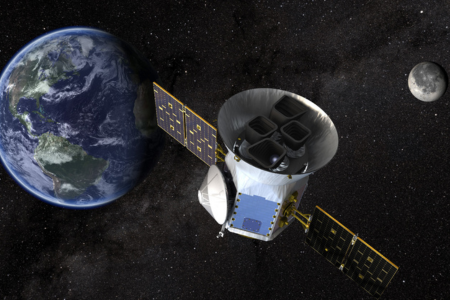NASA's TESS Unearths Two Potential Life-Supporting "Super-Earths"
In a recent revelation, NASA’s Transiting Exoplanet Survey Satellite (TESS) has identified two ‘super-Earth’ exoplanets in the habitable zone of a neighboring star, TOI-2095.
Located approximately 137 light-years away from our solar system, these exoplanets are slightly larger than Earth and they both orbit the same red dwarf star.

The detection of these exoplanets was possible due to the transit method, where they passed, or ‘transited’, in front of their host star, causing a slight decrease in the star’s brightness. By examining these light fluctuations, the existence and some key features of the two planets were discerned.
The red dwarf TOI-2095, despite being cooler than the sun, belongs to the most abundant category of stars in the universe. However, it’s known that red dwarfs are prone to intense bursts of ultraviolet and X-ray radiation during their early stages. This could potentially strip away the atmospheres of nearby orbiting planets, casting doubt on the habitability of such planets, even if they are in the star’s habitable zone, where liquid water could theoretically exist on a planet’s surface.
The intriguing candidates, named TOI-2095 b and TOI-2095 c, are therefore prime subjects for further detailed research. The proximity of TOI-2095 b to its host star is approximately a tenth of the average distance between Earth and the sun. With a diameter 1.39 times that of Earth and potentially 4.1 times its mass, this exoplanet completes its orbit in approximately 17.7 Earth days.
TOI-2095 c, the second planet in the system, is situated slightly further from the star and takes 28.2 Earth days to complete its orbit. It is estimated to have a diameter around 1.33 times that of Earth and potentially up to 7.5 times its mass. Scientists speculate that surface temperatures on both planets could range between 75 degrees Fahrenheit and 165 degrees Fahrenheit (24 to 74 degrees Celsius).
Felipe Murgas of the University of La Laguna in Spain, who led the team that made the discovery, has suggested that the relatively long orbital periods of these two planets could be pivotal in understanding the processes that influence the composition of small planets around red dwarfs.
Since its launch in 2018, NASA’s TESS mission has identified approximately 330 confirmed exoplanets and more than 6,400 potential candidates that require additional study or analysis, showcasing the effectiveness of this mission.
The team plans to conduct further studies on these two super-Earths by precisely measuring their radial velocity, which could help in estimating their masses more accurately, and in turn, determine their densities. This information could aid in understanding whether these planets have retained their atmospheres.
The study was recently uploaded to the preprint server arXiv and awaits peer review.
-
India Successfully Lands Spacecraft on Moon’s South Pole
India achieves a historic milestone by successfully landing Chandrayaan-3 spacecraft on the moon's south pole, marking the nation's ascent to lunar exploration. Learn about the significance of this achievement and its implications for space exploration.Read More -
Timber in Orbit: Japan’s Wooden Satellite Prepares for Launch
In a groundbreaking endeavor, Japanese researchers are challenging conventions by showcasing the unexpected resilience of wood in the hostile environment of outer space. This extraordinary feat raises an intriguing question: could wooden satellites hold the key to a sustainable future for space technology?Read More -
Seradata Welcomes Melissa Quinn: New Horizons with EVONA
Breaking: Melissa Quinn's new role unveiled - placed by EVONA. Discover her transformative journey from Spaceport Cornwall to Seradata.Read More